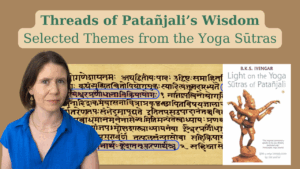
Threads of Patanjali’s Wisdom recording of Session 3
Session 3 – Threads in Patañjali’s Wisdom For Session 4: Āsana as a Path to Samādhi We explore Patañjali’s teaching on āsana, and more

From Book Session: Unit 4 of Geeta Iyengar's Yoga a Gem for Women Basic Asana-s
In “Yoga – A Gem for Women,” Geeta S. Iyengar provides an illuminating exploration of Pascimottanasana, also known as the intense posterior stretch or seated forward bend. This profound posture exemplifies the intimate connection between physical practice and mental well-being in yoga.
Iyengar describes the technical aspects with precision, emphasizing the importance of proper alignment and engagement: “Exhale, bend the elbows slightly, and extend the upper arms outwards. Extend the sides of the trunk and bend forward, touching the thighs. The head should rest beyond the knees.” This physical instruction reveals how each element of the pose builds upon the other, creating a comprehensive effect on the body.
The Mental Transformation
What makes Pascimottanasana particularly remarkable is its profound effect on the mind. As Iyengar states: “The effect of this asana on the mind is magical: an upset, irritated, and restless mind becomes tranquil, and angry, passionate moods, etc., are calmed down. It sharpens the memory and brings clarity of thought.” This observation illustrates how a physical posture can directly influence our mental state.
The Physiological Connection
The text provides fascinating insight into why this pose might have such powerful effects. Iyengar explains: “In the human species, the spinal column is perpendicular to the ground, whereas in animals it is parallel to the ground and the heart is below the spine. Because of the upright position, humans are more prone to strain and to diseases of the heart. In Pascimottanasana the spine is horizontal and parallel to the ground so that the heart is rested.”
The ancient text Hatha Pradipika, which Iyengar quotes, emphasizes the pose’s comprehensive benefits: “Pascimottanasana is the foremost of all asanas. Its effect is that the life force flows through the very intricate channels called nadis, gastric fire is kindled and the stomach becomes free of all diseases.”
The pose’s effects extend beyond the physical and mental realms. Iyengar notes that “In this asana the pelvic region is stretched and the blood circulation there is stimulated. The ovaries, the uterus, and the entire reproductive system are revitalised and their efficiency is enhanced.”
For beginners, Iyengar provides crucial guidance: “Do not cave in the chest to touch the knees. Do not rest the elbows on the ground as this hinders the extension of the body.” These instructions emphasize that the pose’s benefits come not from forcing the position but from mindful, proper execution.
Progressive Approach
The text acknowledges that achieving the full pose takes time: “In the beginning it is difficult to keep the legs stretched. The knees bend and tension is felt in the hamstring muscles… Do not be disheartened. Stretch gradually and with practice all these difficulties will be overcome.” This patient, progressive approach is essential for both physical and mental development in yoga practice.
What makes Pascimottanasana particularly special is how it demonstrates the inseparable connection between physical posture and mental state. The careful attention to alignment, the gradual deepening of the pose, and the resulting mental clarity show how yoga works as a holistic practice, affecting both body and mind simultaneously.
Through this deeper understanding of Pascimottanasana, we can appreciate how a single yoga posture can serve as a powerful tool for transformation, working on multiple levels to bring about physical health, mental clarity, and emotional balance. The pose stands as a testament to yoga’s comprehensive approach to well-being, where physical practice becomes a gateway to deeper mental and emotional harmony.
This ancient posture, when practiced with awareness and proper guidance, offers a pathway to experience the profound connection between body and mind that lies at the heart of yoga practice. As we engage with Pascimottanasana, we’re not just stretching our bodies; we’re participating in a time-tested method for achieving holistic balance and well-being.

Session 3 – Threads in Patañjali’s Wisdom For Session 4: Āsana as a Path to Samādhi We explore Patañjali’s teaching on āsana, and more

Session 2 – Threads in Patañjali’s Wisdom For Session 3: Abhyāsa and Vairāgya We explore the twin pillars that support all yogic transformation: अभ्यास

Session 1 – Threads in Patañjali’s Wisdom For Session 2: Yoga and the Mind We explore Patañjali’s foundational definition: “Yoga is the control of
Agi Wittich is a yoga practitioner since two decades, and is a certified Iyengar Yoga teacher. Wittich studied Sanskrit and Tamil at the Hebrew University of Jerusalem, Israel, completing a PhD with a focus on Hinduism, Yoga, and Gender. She has published academic papers exploring topics such as Iyengar yoga and women, the effects of Western media on the image of yoga, and an analysis of the Thirumanthiram yoga text.